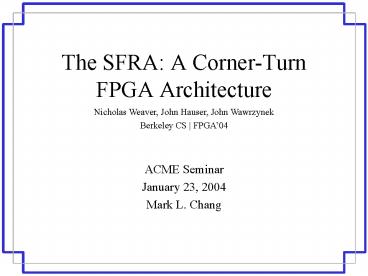The SFRA: A CornerTurn FPGA Architecture PowerPoint PPT Presentation
1 / 26
Title: The SFRA: A CornerTurn FPGA Architecture
1
The SFRA A Corner-Turn FPGA Architecture
Nicholas Weaver, John Hauser, John
Wawrzynek Berkeley CS FPGA04
- ACME Seminar
- January 23, 2004
- Mark L. Chang
2
Fixed Frequency FPGAs
- Conventional FPGAs do not pre-determine clock
frequency - Interfacing with microprocessor requires
compatible clocking schemes - How about a fixed-frequency FPGA?
- Operates at a set clock rate regardless of
configuration - Easier to integrate, higher clock rates
- Good for computations that can be pipelined!
3
Interconnect and Routing
- Interconnect delay dominates conventional FPGAs
- Fixed-frequency generally requires pipelined
interconnect and routing structures - Previous fixed-frequency arrays
- Difficult placement problems
- Highly restrictive interconnect topologies limit
their applicability
4
Other Fixed-Frequency FPGAs
- Garp
- MIPS processor with reconfigurable coprocessor
- Interconnect fabric supported only limited
connectivity - RaPiD / PipeRench
- Coarse-grained array of functional units
- Explicitly pipelined interconnect
5
More Fixed-Frequency Stuff
- HSRA
- Pipelined H-tree for the routing structure
- Retiming chains, programmable delay shift
registers on all inputs to balance delay - Introduces a significant placement problem
- Not Manhattan
- Recursive bipartitioning
- Bad for datapath-oriented circuits
6
The Problem
- Want to leverage conventional placement and
synthesis tools and techniques - Interconnect must be pipelined
- But adding pipelined switches to a conventional
FPGA would be impractical - Too many registers
- Could complicate the routing problem if switches
are not fully registered
7
The FPGA Landscape
8
Corner-Turn Interconnect
- Any-to-any connectivity for very few signals
- Maintains Manhattan placement
- Can be efficiently pipelined
9
Routing Corner-Turn FPGAs
- Global Routing
- Assigns signals to particular channels and turns
- Attempts to minimize the number of turns taken by
each signal - Done in 5 stages
- Detailed routing
- Performs wire assignment within each channel
- Greedy channel-packing technique
- O(N log N)
10
5-Stage Global Routing
- 1 Direct routing
- All nets which can be routed without using turns
are routed - 2 Fanout routing
- Attempt to route large fanout nets to maximize
sharing of turns - Sort all remaining nets by degree of fanout
- Starting with highest, route all nets fanout gt 4
11
Fanout Routing
- Start horizontally or vertically
- Use orientation that uses fewer turns
- Leave unroutable nets to later routing stages
- Lock down routed nets
12
5-Stage Global Routing
- 3 Pushrouting
- Consider all nets as individual point-to-point
signals - Prioritize shorter nets and nets on the critical
path - For each net, only two possible one-turn routes
- If either route is free, assign the turn
- If not free, depth-first search routed nets that
use the two turns to see if an adjustment can be
made to allow routing of the net
13
5-Stage Global Routing
- 4 Zig-zag routing
- Remaining nets are examined to find possible
two-turn routes - Prioritize longer nets, as they have more
possible turns along their route
14
5-Stage Global Routing
- 5 Rip-up-and-reroute
- We want to route any remaining unrouted nets
- For each net, determine if it can be pushrouted
or zig-zag routed - If not, examine the two one-turn route switches
- Breath sic first search on all nets using these
turns - Select one randomly (weighted toward longer
nets), rip up and reroute.
15
Retiming
- In a fixed-frequency FPGA we must either
- Restrict the users designs to meet the arrays
pipeline requirements - Automatically transform designs to meet the
arrays constraints - Feed-forward designs can be repipelined
- Feed-backward designs must use C-slow retiming
16
The SFRA Architecture
- Generally compatible with Xilinx Virtex
- Designs must use a single global clock
- Resets and clock enables must be expressed as
combinational logic rather than using primitives - Cannot use LUTs as RAMs or SRL16s
17
The SFRA Slice
18
The SFRA Interconnect
- I/O on any horizontal and vertical wire
- Every three CLBs bidirectional buffer break
- Every nine CLBs bidirectional register break
19
The SFRA Interconnect
20
The SFRA Tile
- 180nm process, 160,000 square microns
- 3.9x larger than Xilinx Virtex E, 1.5x HSRA
- 300MHz simulation
21
The SFRA Tool Flow
- Begins with Xilinx toolset
- Design entry
- Placement
- Mapping
- Custom tools
- Initial retiming to find critical path
- Global routing
- Detailed routing
- Retiming
22
Evaluating the SFRA
- Benchmarks
- AES encryption
- Smith/Waterman sequence matching
- Synthetic datapath (core of 32-bit CPU)
- LEON 1 microprocessor core (SPARC)
- Xilinx benchmarks done on a Spartan II _at_ 250nm.
Clock rates scaled by 1.4.
23
Evaluating the SFRA
- Benchmarks placed using Xilinx tools
- Maximum effort for all tools
- C-Slow retimed Xilinx implementations
- Used hand- and automatically-placed versions
24
Tool Runtime Results
25
SFRA Performance Results
- Unretimed Xilinx
26
SFRA Performance Results
- C-Slow Xilinx

